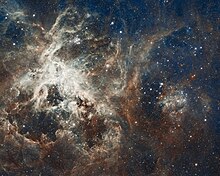31:
85:
417:
441:
429:
54:. A starburst is an astrophysical process that involves star formation occurring at a rate that is large compared to the rate that is typically observed. This starburst activity will consume the available interstellar gas supply over a timespan that is much shorter than the lifetime of the galaxy. For example, the nebula
313:
Lebouteiller, V.; Bernard-Salas, J.; Brandl, B.; Whelan, D. G.; Wu, Y.; Charmandaris, V.; Devost, D.; Houck, J. R. (2008-06-10). "Chemical composition and mixing in giant HII regions: NGC3603, 30Doradus, and N66".
225:
Robitaille, Thomas; Whitney, Barbara (2010). "The present-day star formation rate of the Milky-Way determined from
Spitzer detected young stellar objects".
70:
per million years. Due to the high amount of star formation a starburst is usually accompanied by much higher gas pressure and a larger ratio of
297:
115:
in which the gas pressure is 100 times greater than in the local neighborhood, and it is forming stars at about the same rate as the entire
111:. By contrast, a starburst galaxy is an entire galaxy that is experiencing a very high star formation rate. One notable example is
146:. In the case of mergers, the starburst can either be local or galaxy-wide depending on the galaxies and how they are merging.
407:
461:
289:
30:
104:
119:
in a region only about 600 parsecs (2,000 ly) across. At this rate M82 will consume its 200 million
382:
373:
333:
244:
445:
323:
281:
234:
178: – Type of very massive young open cluster thought to be the precursor of a globular cluster
175:
84:
349:
293:
143:
421:
390:
341:
252:
181:
155:
96:
88:
71:
75:
386:
337:
248:
124:
51:
256:
455:
139:
78:
17:
433:
277:
138:
has a starburst core of about 600 parsec in diameter. Starbursts are common during
95:
Starbursts can occur in entire galaxies or just regions of space. For example, the
108:
169:
161:
135:
131:
120:
112:
67:
59:
353:
201:
116:
63:
55:
35:
158: – Galaxy undergoing an exceptionally high rate of star formation
100:
62:
per million years compared to the star formation rate of the entire
428:
395:
368:
345:
369:"The Inner Ring of NGC 4736: Star Formation on a Resonant Pattern"
328:
239:
83:
29:
130:
Starburst regions can occur in different shapes, for example in
39:
123:
of atomic and molecular hydrogen in 100 million years (its
50:
is a region of space that is undergoing a large amount of
107:
which has one of the highest star formation rates in the
367:
C. Muñoz-Tuñón; N. Caon; J. Aguerri; L. Alfonso (2004).
164: – Starburst galaxy in the constellation Ursa Major
405:
172: – Possible type of luminous blue compact galaxy
91:, the largest starburst region in the local group.
184: – H II region in the constellation Dorado
58:has a star formation rate estimated to be 3600
202:"NOAO: NGC 6334 – A Mini Starburst Region? |"
8:
27:Region of faster than normal star formation
394:
327:
238:
412:
193:
134:the inner ring is a starburst region.
7:
272:
270:
268:
266:
25:
439:
427:
415:
1:
38:, a dwarf irregular galaxy (
257:10.1088/2041-8205/710/1/L11
81:than are usually observed.
478:
290:Cambridge University Press
316:The Astrophysical Journal
227:The Astrophysical Journal
286:Galaxies in the Universe
66:of about seven million
105:Large Magellanic Cloud
92:
43:
87:
33:
18:Starburst (astronomy)
374:Astronomical Journal
387:2004AJ....127...58M
338:2008ApJ...680..398L
282:Gallagher, John III
249:2010ApJ...710L..11R
176:Super star cluster
93:
44:
462:Stellar astronomy
299:978-0-521-67186-6
144:Antennae Galaxies
16:(Redirected from
469:
444:
443:
442:
432:
431:
420:
419:
418:
411:
401:
400:
398:
364:
358:
357:
331:
310:
304:
303:
274:
261:
260:
242:
222:
216:
215:
213:
212:
198:
182:Tarantula Nebula
156:Starburst galaxy
97:Tarantula Nebula
89:Tarantula Nebula
72:hydrogen cyanide
48:starburst region
21:
477:
476:
472:
471:
470:
468:
467:
466:
452:
451:
450:
440:
438:
426:
416:
414:
406:
404:
366:
365:
361:
312:
311:
307:
300:
292:. p. 289.
276:
275:
264:
224:
223:
219:
210:
208:
200:
199:
195:
191:
152:
76:carbon monoxide
28:
23:
22:
15:
12:
11:
5:
475:
473:
465:
464:
454:
453:
449:
448:
436:
424:
403:
402:
396:10.1086/380610
359:
346:10.1086/587503
322:(1): 398–419.
305:
298:
262:
233:(1): L11–L15.
217:
192:
190:
187:
186:
185:
179:
173:
167:
166:
165:
151:
148:
140:galaxy mergers
125:free-fall time
79:emission-lines
52:star formation
26:
24:
14:
13:
10:
9:
6:
4:
3:
2:
474:
463:
460:
459:
457:
447:
437:
435:
430:
425:
423:
413:
409:
397:
392:
388:
384:
380:
376:
375:
370:
363:
360:
355:
351:
347:
343:
339:
335:
330:
325:
321:
317:
309:
306:
301:
295:
291:
287:
283:
279:
278:Sparke, Linda
273:
271:
269:
267:
263:
258:
254:
250:
246:
241:
236:
232:
228:
221:
218:
207:
203:
197:
194:
188:
183:
180:
177:
174:
171:
168:
163:
160:
159:
157:
154:
153:
149:
147:
145:
141:
137:
133:
128:
126:
122:
118:
114:
110:
106:
102:
98:
90:
86:
82:
80:
77:
73:
69:
65:
61:
57:
53:
49:
41:
37:
34:Starburst in
32:
19:
381:(1): 58–74.
378:
372:
362:
319:
315:
308:
288:. New York:
285:
230:
226:
220:
209:. Retrieved
205:
196:
142:such as the
129:
121:solar masses
94:
68:solar masses
60:solar masses
47:
45:
446:Outer space
206:noirlab.edu
109:Local Group
211:2021-04-15
189:References
170:Pea galaxy
162:Messier 82
136:Messier 82
132:Messier 94
113:Messier 82
422:Astronomy
354:0004-637X
329:0710.4549
240:1001.3672
117:Milky Way
64:Milky Way
456:Category
284:(2007).
150:See also
56:NGC 6334
36:NGC 1569
408:Portals
383:Bibcode
334:Bibcode
245:Bibcode
103:in the
42:photo).
352:
296:
101:nebula
434:Stars
324:arXiv
235:arXiv
99:is a
350:ISSN
294:ISBN
40:NASA
391:doi
379:127
342:doi
320:680
253:doi
231:710
127:).
74:to
458::
389:.
377:.
371:.
348:.
340:.
332:.
318:.
280:;
265:^
251:.
243:.
229:.
204:.
46:A
410::
399:.
393::
385::
356:.
344::
336::
326::
302:.
259:.
255::
247::
237::
214:.
20:)
Text is available under the Creative Commons Attribution-ShareAlike License. Additional terms may apply.

